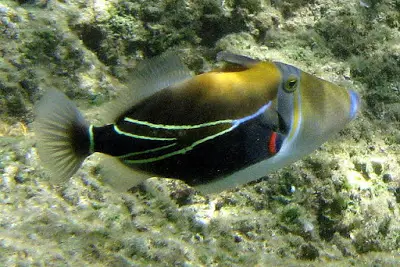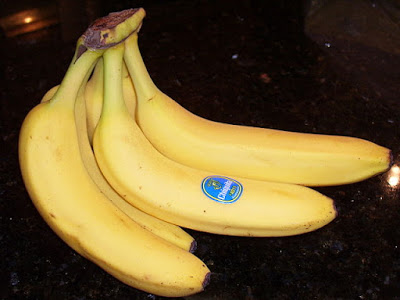 The weekly collection of random and fun facts. In this week’s edition: The Tongue-Twister Hawaiian Fish, The Infinity Symbol, Mailing Bricks, The Banana Clone, and the Least Opened Museum.
The weekly collection of random and fun facts. In this week’s edition: The Tongue-Twister Hawaiian Fish, The Infinity Symbol, Mailing Bricks, The Banana Clone, and the Least Opened Museum.
 |
| Dwijinker/Wikimedia |
Some names can be tough to pronounce, and the official fish of Hawaii could take the prize as the most difficult. The state fish of Hawaii is the humuhumunukunukuapua’a, or if you would rather not tie your tongue in knots, it’s also called the reef, or rectangular trigger fish. In Hawaiian it means “trigger fish with snout like a pig”.
The rectangular trigger fish is a tropical reef fish, and they sometimes make grunting noises to possibly warn of intrusion by predators to their territory which they can be aggressive in defending. The also use jets of water from their mouth to uncover food underneath the surface of the sand and then spit the sand from their mouth. The reef trigger fish also has the ability to change their color depending on if they’re active or not.
The fish hasn’t always been the state fish of Hawaii. It was the official fish starting in 1985 after a public survey, but because the state law expired after five years, it was no longer the state fish in 1990. It wasn’t until 2006 that the humuhumunukunukuapua’a became official again. Source, Source
 The infinity symbol is technically called the “lemniscate” from algebraic geometry. It was first used in the 17th century in written works on conic sections, or curves from the intersection of a cone with a plane. It was also seen on Tarot cards in the 1700s. The loops represent something that has no end and goes on forever. The idea of infinity represented by the symbol is incredibly complex and has been the subject of study of mathematicians, philosophers, scientists, and physicists for centuries.
The infinity symbol is technically called the “lemniscate” from algebraic geometry. It was first used in the 17th century in written works on conic sections, or curves from the intersection of a cone with a plane. It was also seen on Tarot cards in the 1700s. The loops represent something that has no end and goes on forever. The idea of infinity represented by the symbol is incredibly complex and has been the subject of study of mathematicians, philosophers, scientists, and physicists for centuries.
Here’s a simple, but rather mind-blowing concept of infinity. If you stand a foot away from a wall and then move half the distance of each movement to the wall, cutting each movement in half each time you move, will you ever touch the wall? The answer is you will never touch the wall because there are infinite points between you and the wall when you half the distance each time you move. Source
 Sometimes you have to use a little ingenuity to get things done. This was the case in 1916, when William Colthart, the president of a new bank in Vernal, Utah, discovered that the new bricks for his building that were in Salt Lake City would cost more than four times as much to ship than the bricks cost. The post office at the time had just started a new parcel service, and this was when Colthart saw an opportunity.
Sometimes you have to use a little ingenuity to get things done. This was the case in 1916, when William Colthart, the president of a new bank in Vernal, Utah, discovered that the new bricks for his building that were in Salt Lake City would cost more than four times as much to ship than the bricks cost. The post office at the time had just started a new parcel service, and this was when Colthart saw an opportunity.
Parcel post rates were half of what the shipping rates would be for his bricks so Colthart decided to mail them instead, since it was cheaper. He had each bricked individually wrapped and put them in crates of 10 at a time. 50 pound boxes of bricks were mailed until he ended up with around 80,000 bricks (the postal service says it was 15,000). The cost was low for Colthart compared to if he would have chose the other method, but it cost the Postal Service a lot more money to ship them. Bricks were piling up outside the postal office in Vernal since the post master there made them pick up the bricks over the counter. The feat prompted the US Postal Service to put a limit on the weight of a package per day from a person to a recipient of 200 pounds in 1916, but by that time, Colthart already had the exterior of the bank building completely built. Source
 The bananas you buy in the supermarket (the Cavendish variety and the most common) are clones and genetically identical. They are all descended from one single banana. A new banana plant has to be cultivated from an existing banana root, so the bananas we eat are sterile and cannot produce a banana plant.
The bananas you buy in the supermarket (the Cavendish variety and the most common) are clones and genetically identical. They are all descended from one single banana. A new banana plant has to be cultivated from an existing banana root, so the bananas we eat are sterile and cannot produce a banana plant.
It wasn’t always this way. Until the 1950s, the banana of choice was the Gros Michel, but the Gros Michel variety was completely wiped out because of a fungus called fusarium oxysporum that caused Panama disease. This was a disease that affected the roots of the banana plant. The Gros Michel were also clones, and the fungus spread quickly from plantation to plantation. The Cavendish was used to replace the Gros Michel since it was resistant to the fungus, but there is another disease of banana plants called black sigatoka that the Cavendish could be susceptible to. Source
 At the Trinity Site, the spot where the first A-bomb was detonated in New Mexico, there is an interesting and sparse museum that tells of that historic event. What is even more fascinating is the museum is only opened for 12 hours every year; 6 hours in the spring, and 6 hours in the fall. The display for the museum only has a large piece of concrete, an abandoned house, and a few bits of glass.
At the Trinity Site, the spot where the first A-bomb was detonated in New Mexico, there is an interesting and sparse museum that tells of that historic event. What is even more fascinating is the museum is only opened for 12 hours every year; 6 hours in the spring, and 6 hours in the fall. The display for the museum only has a large piece of concrete, an abandoned house, and a few bits of glass.
There’s a good reason it’s only opened for such a short time. The site sits on the White Sands Missile Range, which spreads about 2-million acres, and is about 62 miles away from the more full-time museum of the missile range, though the route to get to it is much longer. Since White Sands is an active training site, the government obviously doesn’t want tourists wandering around. Most of the other things after the first blast were buried since they were radioactive, and the ones that are displayed are sealed in a glass case. Source
That’s it for another edition. Impress everyone with your new knowledge, they’ll appreciate you for it.
Past Issues of the Completely Random Facts of the Week

